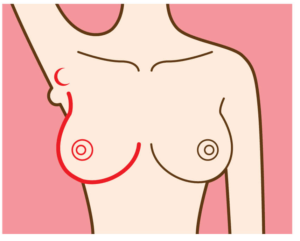The incidence of Breast Cancer is increasing and the earlier it gets diagnosed, the better the chance of successful treatment. Needless to say, everyone’s breasts are different, some people have lumpy breasts, some have differently sized breasts or some have differently shaped breasts. Thus it is important for women to check their breasts at regular intervals and know how their breasts seem and feel normally. Make a conscious effort to look at and feel your breasts often – for instance, when you are in the shower, while applying a body cream or while changing garments. Besides breasts, keep checking your armpits and up to your collarbone.
Once you are breast-aware, it would become easy to detect any anomalies and seek doctor’s advice in time.
CHANGES WHICH ARE NORMAL
As you progress through life and its stages (i.e. puberty, adolescence, menarche, the reproductive years, the breastfeeding years and the menopause), the breasts keep changing.
DURING PERIODS
It is possible that breasts feel heavier, tender, lumpier or fuller before your periods. Many women also report of breast pain during periods, which is seemingly normal.
DURING AND AFTER PREGNANCY
A woman’s breasts undergo very visible changes during and after pregnancy including but not limited to tingling, nipple soreness, a proliferation of breasts and areola, darkening of nipples and areola, etc.
BEFORE AND AFTER MENOPAUSE
Owing to the decreasing oestrogen levels during and after menopause, a woman’s breasts may change in size, firmness (becoming softer and drooping), tenderness and even lumpy. These lumps often turn out to be breast cysts (fluid-filled).
CHANGES WHICH MAY NOT BE NORMAL
Breast cancer can cause signs and symptoms that include changes to the skin on and around the breast. While many conditions can potentially cause breast changes, including cysts, infections, eczema, and dermatitis, a person should not automatically rule out breast cancer.
 LUMPS- VISIBLE OR FELT
LUMPS- VISIBLE OR FELT
A breast lump or mass (marble-like) is the most common and one of the most possible signs of breast cancer. One can feel it like a hard knot or thickening in the breast or under the arm. It is important to feel the same area in the other breast to make sure the change is not a part of healthy breast tissue in that area. Lumps associated with breast cancer are usually painless, although some may cause a prickly sensation.
 ARMPIT SWELLING
ARMPIT SWELLING
Swelling in your armpit or collarbone could also mean breast cancer has spread to lymph nodes in that area. This swelling may come before you feel a lump, so let your doctor know if you notice it.
 CHANGE IN SIZE OR SHAPE OF BREASTS
CHANGE IN SIZE OR SHAPE OF BREASTS
If there is a visible change in the shape or size of breasts or one of the breasts, one should seek advice. For example, one breast might become larger or lower than the other.
 CHANGE IN SKIN TEXTURE
CHANGE IN SKIN TEXTURE
Breast cancer can cause inflammation in skin cells, which in turn leads to a change in texture. Some of the observable changes are scaly skin around the nipple, extremely dry skin thickening in any part of the breast. Such scaliness may cause itching and it is symptomatic of a rare type of breast cancer called Paget’s disease. Benign skin conditions or allergies may also cause such a change in skin texture.
 CHANGE IN COLOR OF BREASTS
CHANGE IN COLOR OF BREASTS
Breast cancer can make the breast area appear discolored or bruised. The skin may become red, purple or bluish. If you have not experienced a recent shock to the breast to explain such discoloration, it is vital to see a doctor.
 CHANGE IN NIPPLES
CHANGE IN NIPPLES
Breast cancer can cause cell changes behind the nipple. Any physical changes in the nipples such as , retraction (turning inward) or soreness, dimpledness or itchiness should be informed to the doctor and medical advice should be sought.
 NIPPLE DISCHARGE
NIPPLE DISCHARGE
It is normal for breastfeeding women to have milky discharges from the nipple. In other cases, if a woman observes a nipple discharge, ranging from clear to milky to yellow, green or even red, it is advisable to see a doctor. Although most nipple discharge is non-cancerous, it may signify breast cancer in some cases.
Women should not panic or be fearful when they notice the above-mentioned or any other breast changes. Aging, changes in hormone levels, and other factors described above can lead to breast changes. Most breast changes are normal or occur due to a benign (not cancer) breast condition, but it’s important to find out what’s causing the change.
Being proactive about breast-health and visiting a doctor to confirm any breast symptoms is much needed, considering the incidence of breast cancer in the population. Seeing a doctor for a confirmation check can help determine if any breast changes are a cause for concern.
Get a glimpse of all symptoms of breast cancer described above in a video format here: https://youtu.be/ictjZMs4MqI (This video is issued by Breast Cancer Now in public interest.)

 LUMPS- VISIBLE OR FELT
LUMPS- VISIBLE OR FELT ARMPIT SWELLING
ARMPIT SWELLING CHANGE IN SIZE OR SHAPE OF BREASTS
CHANGE IN SIZE OR SHAPE OF BREASTS CHANGE IN SKIN TEXTURE
CHANGE IN SKIN TEXTURE CHANGE IN COLOR OF BREASTS
CHANGE IN COLOR OF BREASTS CHANGE IN NIPPLES
CHANGE IN NIPPLES NIPPLE DISCHARGE
NIPPLE DISCHARGE